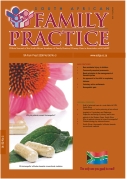Audit of Antenatal Care at a Rural District of KZN, South Africa
Keywords:
Antenatal care, Empangeni hospital, antenatal visit, gestational age.
Abstract
Background: Maternal and perinatal mortality remain a big challenge in developing countries, including South Africa, where the figures are amongst the highest in the world. Provision of adequate antenatal care is regarded as a cornerstone of maternal and perinatal health care and is expected to have a considerable impact on achieving the Millennium Development Goals. The detection of high-risk pregnancies through antenatal care has been advocated as a good tool to reduce maternal mortality in developing countries. The South African Government’s response in terms of providing free maternal care in public health facilities is commendable but access to quality antenatal care is still questionable. We conducted this audit to evaluate the quality of antenatal care/services provided against the set national standards at the first (booking) visit, and visits at 28 and 36 weeks of gestation, as part of a quality improvement initiative. Methods: A retrospective cross-sectional descriptive study was undertaken, targeting women who attended public health institutions for antenatal care in the Empangeni sub-district of Uthungulu, which is a health district in KwaZulu-Natal province. Data were collected from 244 pregnant mothers’ antenatal care records after delivery, and a random selection from a total of 5 109 women who delivered in Empangeni hospital during July to December 2004. Frequency tables were produced on the predetermined selective antenatal care indicators. A Pearson correlation test was conducted to determine the significant relations, if any, among variables. Results: The majority of the pregnant mothers were unemployed and poor. Virtually all of them (99.6%) had attended public healthcare (PHC) facilities for antenatal care (88% attended PHC clinics and the rest attended hospitals) and each woman had, on average, six antenatal visits. One quarter did not enrol for a prevention of mother-to-child transmission (PMTCT) programme. Only 9% of pregnant women booked a visit during their first trimester period but most of them (two-thirds) booked a visit during the second trimester of pregnancy. History-taking was done for every woman. Recording of haemoglobin (Hb) estimation was high at the first visit (95%) but low at 28 and 36 weeks (46% and 30% respectively). Recording of syphilis screening was very low (18%) at the first visit and only 2% was screened at 36 weeks. Only 16% received adequate treatment in cases where the results were positive. At 36 weeks, only 2% had a Wasserman reaction (WR) test done to screen syphilis at term. Over half (55%) of the pregnant women received three doses of tetanus toxoid vaccination before delivery. Conclusion: The study showed that the standard of antenatal care offered in the Empangeni sub-district fell short of the required level. This lack of proper care represents missed opportunities to impact optimally on maternal and perinatal health outcomes. Thus strategies are urgently needed to improve antenatal care through a quality improving initiative.
Published
2008-03-26
Section
Original Research
By submitting manuscripts to SAFP, authors of original articles are assigning copyright to the South African Academy of Family Physicians. Copyright of review articles are assigned to the Publisher, Medpharm Publications (Pty) Ltd, unless otherwise specified. Authors may use their own work after publication without written permission, provided they acknowledge the original source. Individuals and academic institutions may freely copy and distribute articles published in SAFP for educational and research purposes without obtaining permission.

